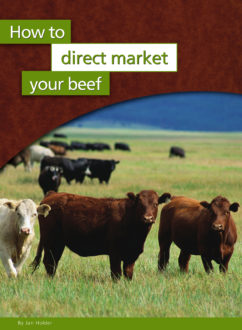
When first starting out to market your own beef, one of the first problems you will face is that it is easy to sell the high-end cuts and hard to sell the low-end cuts.
Restaurants love buying steaks from local ranchers, but steaks only make up about 10 percent of the carcass. You still have a lot of beef to sell.
Conventional beef marketing deals with this problem by using price. That’s why chucks, hamburger and rounds are cheap, and loin steaks and tenderloin are expensive, because everyone wants steaks and tenders. Every day, they have so much beef to sell, and they get on the phone (just like the trading floor of the stock exchange) and sell their beef. Because fresh beef has a limited shelf life, they have to sell it before it spoils. As the industry saying goes, “You have to sell it before you smell it.” They just keep going down in price until all their beef is sold.
Marketing on a smaller scale, you can pick your customers and select them in the right proportions to what you need to sell. For example, if a restaurant wants 50 pounds of tenderloin a week, you will have to match that demand with customers who are willing to buy 1,000 pounds of hamburger a week.
Of course, you can always sell your other cuts on the conventional market, but you’ll have to accept a very low price. Most big meat distributors only deal in huge quantities, which makes it hard for small marketers to “dump” what they can’t sell.
You’ll also find that the low-end cuts are much more price sensitive than the high-end cuts. You might be able to charge double or triple market price for your tenderloin, but you may have to settle with just 10 to 20 percent more for your ground beef.
Initially, you will probably sell out of steaks and be left with ground beef, limiting your overall sales. People seem ready to pay for a premium steak but balk at $3-a-pound ground beef.
They may not realize there is a difference between yours and the 60-cent-a-pound supermarket version. Once they are hooked on your steak, give them a free pound of ground beef. One pound will usually convince them to buy a balance of all of your cuts.
To make things even more difficult, there are a few cuts in the middle that no one really knows about. People know what a steak is and what hamburger is, but what’s a tri tip? What’s the difference between a flank and skirt? Being small, you will have a lot of face-to-face interaction with your customers, so you can educate them on how to cook the different cuts.
I’ve found that with a little planning you can proportion your customers to match how you cut up the carcass and not be forced to sell for a lower price just to get rid of all your beef. You will want to find a lot of hamburger buyers, because about 50 percent of your carcass will be hamburger.
Another way of dealing with the lower demand and lower-priced cuts is to add value to them. The margins on a round roast are not very large, but if you make that round roast into jerky or a ready-to-serve marinated roast, suddenly you’ve got products that rival the loin steaks in profitability. So if you can’t sell it, rather than take a lower price, be creative and think what you could turn it into.
